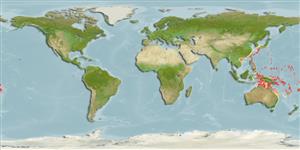>
Eupercaria/misc (Various families in series Eupercaria) >
Labridae (Wrasses) > Cheilininae
Etymology: Cirrhilabrus: Latin, cirrus = curl fringe + Greek, labros = furious (Ref. 45335).
More on author: Randall.
Environment: milieu / climate zone / depth range / distribution range
Ecología
marino asociado a arrecife; rango de profundidad 10 - 50 m (Ref. 37816). Tropical
Distribución
Países | Áreas FAO | Ecosistemas | Ocurrencias, apariciones | Point map | Introducciones | Faunafri
Western Pacific: Miyake-jima, Izu Islands, Japan, Guam and the Mariana Islands.
Tamaño / Peso / Age
Maturity: Lm ? range ? - ? cm
Max length : 7.1 cm SL macho / no sexado; (Ref. 5278)
Short description
Claves de identificación | Morfología | Morfometría
Espinas dorsales (total) : 11; Radios blandos dorsales (total) : 9; Espinas anales: 3; Radios blandos anales: 9. Juveniles and females nearly uniformly orange-red. Males develop elongate pelvic fins and have brilliant blue bands on dorsal and anal fins.
Known at depths ranging from 10 to at least 40 m at exposed outer reef areas than in lagoons or harbors. Occurs in aggregations. Maximum depth reported taken from Ref. 128797.
Life cycle and mating behavior
Maturities | Reproducción | Spawnings | Egg(s) | Fecundities | Larva
Distinct pairing during breeding (Ref. 205).
Randall, J.E., 1992. A review of the labrid fishes of the genus Cirrhilabrus from Japan, Taiwan and the Mariana Islands, with descriptions of two new species. Micronesica 25(1):99-121. (Ref. 5278)
IUCN Red List Status (Ref. 130435)
Threat to humans
Harmless
Human uses
Herramientas
Special reports
Download XML
Fuentes de Internet
Estimates based on models
Preferred temperature (Ref.
123201): 25.5 - 28.9, mean 27.7 °C (based on 124 cells).
Phylogenetic diversity index (Ref.
82804): PD
50 = 0.5000 [Uniqueness, from 0.5 = low to 2.0 = high].
Bayesian length-weight: a=0.01585 (0.00707 - 0.03555), b=2.95 (2.76 - 3.14), in cm total length, based on LWR estimates for this (Sub)family-body shape (Ref.
93245).
Nivel trófico (Ref.
69278): 3.3 ±0.4 se; based on size and trophs of closest relatives
Resiliencia (Ref.
120179): Alto, población duplicada en un tiempo mínimo inferior a 15 meses (Preliminary K or Fecundity.).
Fishing Vulnerability (Ref.
59153): Low vulnerability (10 of 100).
Nutrients (Ref.
124155): Calcium = 142 [82, 299] mg/100g; Iron = 1.04 [0.58, 2.05] mg/100g; Protein = 18.1 [15.2, 20.4] %; Omega3 = 0.18 [0.10, 0.32] g/100g; Selenium = 22.1 [11.4, 45.5] μg/100g; VitaminA = 290 [86, 1,071] μg/100g; Zinc = 2.06 [1.32, 3.28] mg/100g (wet weight);
